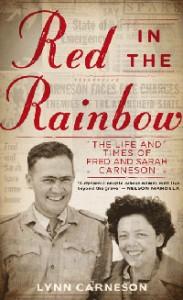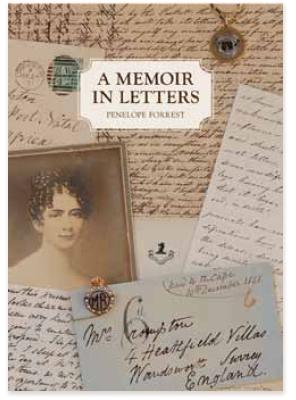

Two South Africans from different family backgrounds have done this successfully and published books that tell stories of their families. One is a story of the Carnesons, written by Lyn Carneson McGregor, daughter of Fred and Sarah Carneson who were prominent members of the Communist Party in South Africa. The other is that of the Phelps family, who have accumulated a collection of letters that enabled Penelope Forrest to write a family history spanning seven generations. Her book is titled A Memoir in Letters of the Phelps and Crompton Families in the Nineteenth and Twentieth Centuries, and it gives an account of family life and culture in England, Madeira and South Africa. What I found captivating about the act of telling a family history in such a public way was the intention behind the act of reproducing the box, suitcase and crate into a more public record. I set out to meet the two authors in search of answers.
Albie Sachs, in his review of Lyn Carneson McGregor’s book that is poignantly titled Red in the Rainbow:The Life and Times of Fred & Sarah Carneson says it is a story like that of countless South Africans, one that has never been fully told. The author agrees and feels that the story of her parents, who dedicated their lives to the struggle against apartheid, is currently not being told because it does not quite fit within the grand narrative of black people fighting the white apartheid state. The Carnesons are white and even though they are known by their fellow comrades for their contribution and sacrifice over many years, in terms of the dominant liberation heritage there is very limited space for people like them, except for the Ruth Firsts or Joe Slovos. The author told me of the outrage she experienced upon her return from exile in England. Even though Carneson McGregor emphasises that the reason she decided to write her book is because her father had asked her to do so, she also points out that it was this outrage that triggered the writing process.
Finding a country that is more divided than before, where corruption is the order of the day amongst those she once called comrades, was the source of this outrage. The betrayal of uMkhonto we Sizwe veterans and the lack of conscious healing in South Africa in the present was cause for concern, especially as her father had given up his life and sacrificed his time for the liberation of South African people. So is the book telling a political story? The author insists that the book is still primarily a family history; however, it is a family history with a political outlook, as the Carneson family’s story cannot be written without writing the history of the struggle against apartheid. Letters in this family archive are almost exclusively prison letters, and family photographs with an obvious absence, in the form of a father who was imprisoned. Even newspaper clippings that are used are those that report on political rallies and political events that family members participated in.
To augment her narrative, South African History Online assisted Carneson McGregor in getting her chronology right. She also depended a great deal on oral history and this entailed conducting interviews with comrades who had worked closely with Fred Carneson. This, she argues, was done so as to ensure that all three narratives can run parallel to and augment one another as she believes that any kind of history (written and oral) is an interpretation of events that were captured by a person. Carneson McGregor says the writing process had a healing function for her in regard to the suffering the family experienced collectively; the publishing thereof is so that the public can bear witness to this suffering. Carneson McGregor argues that publications such as hers may be a useful resource for learners, history students and scholars, but also for the general public as it is written in a way that is it is accessible.

Forrest also found some very helpful websites when she came across references in the letters which needed explanation. There was one which specialised in outdated medical terms which helped her decipher the name (misspelt) of a disease we no longer hear of. The Anglo-Boer War website also gave a lot of help and various people answered questions about the Dorcas Society, Governors of Aden, bishops of Newfoundland and so forth. She also admit that she spent many fruitless hours following links which led to frustrating dead ends and frequently wished her mother or grandparents were available to answer some of her questions. She had to keep reminding herself that she was not writing a doctoral thesis, but simply wished the letters to tell their own stories with whatever additions she was able to make.
As opposed to Carneson McGregor, Forrest feels that her book, as well as the experience of the writing process, cannot be of much help to anyone as she believes that she is no expert in the matter, but just happened to find herself in possession of a suitcase full of letters. According to Verne Harris, the act of bequeathing is one of the factors that need interrogation when dealing with family archives. He also argues that understanding family archives is dependent on understanding family politics, because decisions have to be made about which stories are to be passed on and which ones are to be kept secret. Thus the private nature of this type of archive is no different from other forms of archives such as state archives. The difference is that the focus is much narrower as it concerns the nuclear family and at times, the extended family.
When family archives are published as books, they are no longer private, but become available for public consumption, to perform certain functions in the present. However, what happens with the actual archive in the form of original letters and photographs? Does the family continue passing these down to the generations that follow? If this happens, is it always guaranteed that they will be cared for by the family? What of the Carneson family archive, one that transcends the private and operates in the public realm, because of its political nature? The custodial functions that have been adopted by alternative archives such as The South African History Archive (SAHA) and other memory institutions that have tried to care for these marginalised archives may prove to be unsustainable in the long term. These alternative archives’ functions are not coordinated and require large sums of money for their continued existence. Can this type of archive be cared for by an institution, for example a university? More consideration needs to be given about the best ways of storing and making available this type of archive.
Sources
1. McAlister, H. 2011. “Tale Woven Out of Keepsakes”. In Sunday Argus (25
September, 2011)
2. Sachs, A. Preface. In Red in the Rainbow by Lyn Carneson McGregor
3. Harris, V. 2011. “Archons, aliens and angels: Power and politics in the
archive”. In Hill (Ed): The Future of Archives and Recordkeeping: A Reader.
Facet Publishing: London
4. Personal Conversation with Lyn Carneson McGregor. October 2011.
Red in the Rainbow is available
from bookshops
A Memoir in Letters is self
published by the author. See flyer below.
B